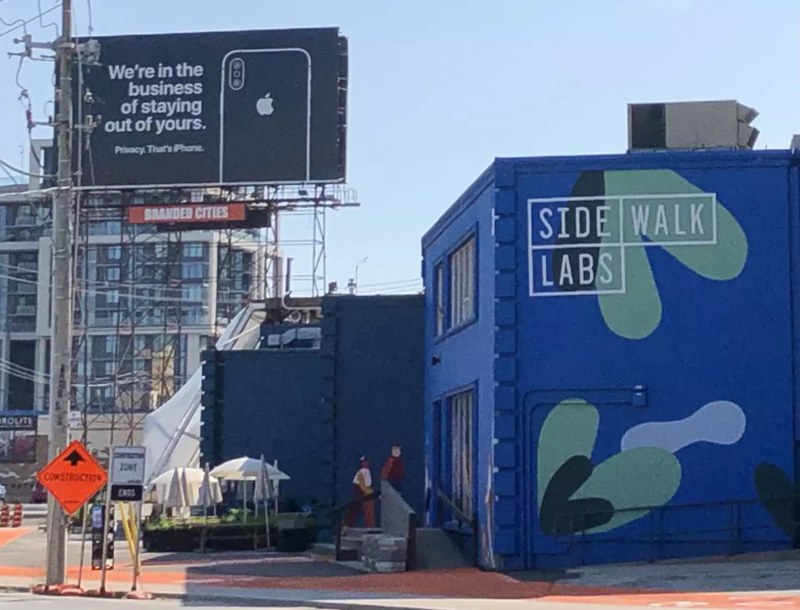Ten Reasons to say No: A Primer on Sidewalk Labs’ Plan for Toronto
Our eastern waterfront is at risk of becoming a virtual Googlopolis. It began innocently enough. Waterfront Toronto, an agency with representatives from all three levels of government and charged with the responsibility of developing waterfront areas, issued a call for proposals for a “funding and innovation partner” to develop Quayside, a 12-acre site at the foot of Parliament Street.
 Sidewalk Labs won the bid. Sidewalk Labs (SWL) is a Google sister company and subsidiary of Google parent company, Alphabet.
Sidewalk Labs won the bid. Sidewalk Labs (SWL) is a Google sister company and subsidiary of Google parent company, Alphabet.
Waterfront Toronto is now reviewing the Sidewalk Labs proposal and simultaneously negotiating some of its terms. After completing this chaotic assessment process, Waterfront Toronto will accept, reject or suggest further modifications to the plan. It will then make recommendations to the City of Toronto, the provincial and the federal government.
The problem? Sidewalk Labs has used the winning bid as a platform to launch a hugely different kind of development project and a land grab that dwarfs the original site.
Anchored by a relocated Google Canadian headquarters, Sidewalk Lab proposes a new zone that would be governed by a handful of new public/private administrative bodies operating with rules and regulations that are different from the rest of the city. Google would build a city within our city, one that risks becoming a virtual gated community like company towns of the past. It’s the 21st century version, dressed up as a ‘smart city’.
The company wants to set up a separate, largely distinct urban zone on Toronto’s waterfront where it can develop and sell ‘smart city’ technologies. Everything and everyone in the zone will become the ‘subject’ of a mega-data stream of behavioural, personal, technical and facility information, collected by thousands of cameras and sensors that Google will mine, manipulate and profit from. It becomes a lab where the model is incubated and tested for global markets.
The entire process of selecting Sidewalk Labs as the “partner,” the behaviour of Sidewalk Labs and the content of its 1500 plus page Master Innovation and Development Plan (MIDP) all raise serious issues about how we plan and develop our waterfront. Behind all the glitz and ‘future tense’ technology are some very basic issues. Whose priorities are being served? Whose needs are at the centre of the discussion and in whose interests are we about to build on the waterfront?
What follows is a brief review of Sidewalk Labs’ plans. It outlines some of the reasons to say no to corporate control and to insist instead, on a democratic and citizen driven process for waterfront development.
A Flawed Process and a Worse Result
From the start Waterfront Toronto’s Request for Proposals (RFP) for the Quayside project was a highly contentious process. Equally so is the relationship between Sidewalk Labs and Waterfront Toronto.
The Ontario Auditor General’s 2018 report highlighted a number of irregularities in the RFP selection process. For instance, Sidewalk Labs received more information than other prospective bidders. And it was given an inside track even before the official Request for Proposals was underway.
The approval process was rushed and politically motivated. For example, Prime Minister Trudeau was scheduled to be part of a press conference announcing the deal before the Waterfront Board had adequate time to even review the details.
Once it won the bid SWL began to flex its corporate muscle and assert control. SWL went from being a so-called partner with Waterfront Toronto to being the lead developer. The company ignored much of the RFP and where it couldn’t, it rewrote the terms and conditions.
SWL worked the backrooms. It waged an extensive lobbying campaign to gain political licence for its plans. It mounted an ongoing effort to get influence shapers on side. It launched a public consultation campaign that was more a marketing effort than an attempt to solicit public concerns. And the feedback it received was ignored. At the same time SWL forced those whose role was to review and comment on the plans, such as members of the Digital Strategy Advisory Committee, into confidentiality and nondisclosure agreements.
In June of 2019 concerns with the process and the plan were heightened when SWL presented a massive report whose objective was to claim control over the eastern waterfront. The RFP had set out 12 acres for Quayside. SWL’s plan foresees control over 190 acres. It wants to buy public land at greatly discounted rates and it wants to be in charge. It is a complete reversal of the normal RPF process. Here we have the vendor (SWL) telling Waterfront Toronto what the company wants to build and what governments have to do to make it possible and profitable for them to do so. Despite this abuse Waterfront Toronto continues to discuss the terms of the plan with Sidewalk Labs.
The Canadian Civil Liberties Association has launched a legal challenge to the process and announced in a press release:
“The Google-Waterfront Toronto deal is invalid and needs to be reset. These agreements are contrary to administrative and constitutional law, and set a terrible precedent for the rest of the country.”
The MIDP is not a Plan
The MIDP (Master Innovation and Development Plan) sprawls over 1500 pages. It meanders over four volumes. It seduces more than informs.
According to the plan there will be dozens of mixed-use, high-rises, many at 30 stories and built out of wood. There will be over 50,000 residents living in condos and purpose-built rental units. There will be hundreds and thousands of square feet of office space, enough to house about 40,000 office workers. Google loves reconfigurable space: parking garages which can be turned into living lofts, public space which can be turned into popup retail spots, lighted digital curbs that can change the lanes in roadways, living lofts that can be used for goods production, and ground floor units (STOAS) that can be shaped and shifted in rapid response to market changes
SWL would have us see in Quayside and the IDEA district the contours of a utopian, smart city. Roads will be made from interchangeable heated pavers, there will be driverless cars and self-driving transit shuttles, parks and waterfront promenades filled with art and amusements, a thermal loop heating system, roof and façade photovoltaics, a robot powered waste management system, an automated underground delivery system, retractable canopies and heated bike and pedestrian paths, wireless connectivity, and efforts to manage wind, sun and precipitation to increase time outside. On first blush It is understandable why some are infatuated with aspects of the project.
But it is not a plan.
The document is vague and confusing, unwieldy, repetitive and disorganized. It spreads discussion of single issues across different volumes without adding much more substance. It is difficult to access and it is harder to read. There is not even a reliable table of contents.
After much criticism SWL is now making the documents available in an easier to access format. But that won’t change how the report is written. It has all the feel of a sales promotion and marketing presentation rather than a document to be accessed and used, studied and reviewed. The reader is left with more questions than answers and a growing level of discomfort of what this ‘plan’ is really all about.
The language in the MIDP is deliberately non committal. It is full of ‘coulds’ and ‘maybes’, and meaningless phrases such as, SWL will “catalyze the potential” to do this thing or that. There are few commitments just possibilities. There are no hard guarantees only vague promise. There are no assurances only suggestions. The MIDP is quite clear when it comes to what SWL wants and plans to get but much less clear as to what SWL plans to give.
Transferring Public Resources for Private Profit
Toronto’s eastern waterfront is a large chunk of land that some have described as one of the largest urban areas for redevelopment in North America. To make that redevelopment possible requires a massive commitment of public resources. If the plan goes ahead there will be a huge transfer of public monies to help Sidewalk Labs and Google make more money.
The first piece of that public commitment is the $1.25-billion to the project to redirect and naturalize the Don River and protect a vast swath of the waterfront area from flooding. This project is already underway. Another piece is the proposed $1.2-billion LRT line from Union Station along the eastern waterfront and servicing the proposed developments and Google’s relocated headquarters. SWL has made it clear that “Quayside and the Eastern Waterfront cannot be developed without rapid transit.”
In addition, the proposal is dependent on the government giving up hundreds of millions in real estate value so that SWL can get access to land at below market value. A September 18, 2019 article in the Globe and Mail estimated the discount to be worth around $500-million.
The MIDP also requires hundreds of millions in public funding to realize the affordable housing proposal. Waterfront Toronto has estimated the amount at over $900-million.
Some of the funds required to create SWL’s proposed management agencies will be money reallocated from existing Toronto departments and agencies. And these organizations will likely require additional ongoing operating capital from government.
And Toronto residents will likely be on the hook for even more money. Money for new organizations that aren’t successfully ‘self funded’. Money for new and at times unproven technologies that need to be repaired, refreshed and replaced. Money to pay for what happens when things go wrong.
At a time of scarce resources and competing priorities SWL’s plans require public resources to be siphoned off from other parts of the city where they are desperately needed. If the development of the waterfront is so dependent on public resources then why is all the development in private hands? Why isn’t there a discussion of public ownership, co-operative development of housing and even workspaces? Why isn’t there more discussion about public space and common wealth and less about privately controlled public space and private wealth?
Sidewalk Labs has not Built Cities
SWL proposes to be the real estate developer for Quayside and Villiers and a lead player for the entire 190 acres that it calls the IDEA district. Even if some of the initiatives in the MIDP appear attractive, even if some of them are exciting, the basic question remains: Why SWL?

The company has no track record at building affordable housing, no track record in building municipal infrastructure, no experience in constructing buildings out of wood, no experience in manufacturing cross laminated timbers, no experience in designing municipal waste structures, no experience in building thermal loop heating systems, and on and on. It is simply the case that SWL doesn’t have the required project management skills and experience to do any of this. And that matters a lot:
- One of the few things that SWL has developed is a project in New York where it has installed dozens of contentious information and surveillance kiosks around the city.
- Its sister company, Google, has a track record of abandoned projects. Recently Google had a project in Louisville, Kentucky to install ultrafast internet. The city saw it as a smart city initiative and an opportunity for economic development so it sweetened the deal. The project involved what Google called nano-trenching and described as an ambitious and ‘lean into’ innovation. It didn’t work out and Google ditched the project, abandoned customers, messed up the city’s roads and dashed economic hopes.
SWL’s parent company, Alphabet, also has a track record of winding down subsidiaries. There is no guarantee that SWL will exist in five years time. The Google suite of companies has little to offer Toronto when it comes to building resilient, equitable and integrated communities.
Little Commitment to Good Jobs
In a massive document, spanning over 1500 pages, it is surprising how few of those pages are devoted to a discussion of jobs. The SWL planning horizon extends beyond 2040 and yet there is no vision of what work could be like in the future. There is no discussion of how productivity gains could result in shorter work time without a decline in wages. There is no talk about more cooperative work settings, no discussion of an end to precarious work and the gig economy, no comments on employment standards or labour rights. In terms of jobs, Google’s city of the future looks a lot like it does today.
The MIDP makes claims for the creation of tens of thousands of jobs. But there are no job targets in the report and no actual plans for purposeful job creation. Instead there are a number of statistical calculations and mathematical estimates about the job possibilities.
To be sure, if the project goes ahead, there will be jobs created on the waterfront. There will be the construction jobs created in infrastructure projects and buildings. There will be jobs related to the production of cross laminated timber (CLT) for use in the buildings. There will be jobs associated with the relocated Google HQ and innovation campus. And there will be the permanent jobs when the entire project is completed.
Construction jobs
The MIDP estimates that there will be 136,000 person years of construction employment over the 20 plus years of the project. If the development happened at a uniform rate that works out to be about 6,800 construction jobs for 20 years. In addition, there will be another 38,000 person years in infrastructure building. Many of these jobs will be there regardless of who builds the waterfront. The composition and the nature of the jobs no doubt will vary (more wood based and less steel and concrete.) SWL wants to reduce the number of potential direct construction jobs by using flexible and modular building components manufactured offsite. These components would range from timber supports and roof modules to internal fittings such as entire bathrooms. SWL is betting heavily that timber buildings will speed up the construction time by a whopping 30% thereby reducing on-site labour.
Timber Factory
SWL plans to build a timber factory on the waterfront capable of supplying all the cross-laminated timber required for the development. The MIDP states this would “support an estimated 2,500 person-years of full-time employment over 20-years.” (125 jobs for 20 years). The phrasing suggests that these jobs would be at the factory but as the technical appendix points out these jobs would actually be spread across manufacturing, sawmill and forestry operations and transportation.
Google HQ
The relocation of Google’s Canadian HQ to the area is probably the clearest commitment that SWL makes in the MIDP. At the outset the relocated HQ was to be part of the 12-acre Quayside development. But that changed and it is now to be located on Villiers Island, on a parcel of land that wasn’t part of the RFP and which isn’t owned by Waterfront Toronto.
SWL repeatedly boasts that much of the future economic growth and innovation on the eastern waterfront is tied to the Google HQ. And yet very little is actually said about it. The relocated Google headquarters, according to the MIDP, will “accommodate as many as 2,500 jobs” implying there will be enough office space to accommodate that number of workers. It goes on to point out that, “the majority of which would be for Google employees.” In other words, there won’t be 2500 Google employees. The timeframe for these jobs is unclear. Elsewhere in the report, the job numbers are at full buildout in 2040. It is also unclear how many of these jobs will be new jobs and how many will be relocated from Google’s existing HQ in Kitchener-Waterloo. Despite all these qualifiers SWL makes it very clear that there are no certainties. Instead “actual hiring will depend on market conditions and business requirements.” In the technical appendix that supports the job and economic analysis of the MIDP there are more details and more time spent on tourism than on the impact of Google’s HQ.
Permanent jobs in the future
According to the MIDP, in 2040, over twenty years from now, there will be 44,000 permanent jobs directly created on the eastern waterfront. The report says that most of these will be ‘net new’ jobs but does admit that a portion of these jobs “would be relocated to the district from elsewhere in the city.”
This number of jobs expected in 2040 is a rough estimate. SWL contracted out the analysis to a third party who did the calculations based on SWL’s assumptions and its best-case scenario. The estimate is derived by using ‘employment density’ calculations that use floor space per worker estimates for various building types.
The nature of these jobs is also a relatively crude estimate. The analysis takes current job composition patterns for comparable municipalities and then tweaks it a bit. On that basis it guesses that there might be about 40,000 office workers in the zone. There will also be pop up entrepreneurial jobs, jobs for ride hail drivers, restaurant and retail jobs and “those working from home.”
SWL asserts that a higher percentage of jobs would be created in fields such as professional, scientific and technical. On the other hand, it is clear that Big Data companies typically rely on contractors who employ lots of insecure, temporary jobs wherever they do business. Temps, vendors and contractors (TVCs) already outnumber direct Google employees by about 135,000 to 115,000.
Skills and the employment initiative
To its credit SWL does propose some initiatives around training and skill development and it was required to support Waterfront Toronto’s Employment Initiative by hiring workers from historically disadvantaged groups. Nevertheless, there are concerns. The training and skills development initiatives are framed in terms of Google’s corporate controlled proprietary programs such as, ‘Grow with Google’. In supporting the Employment Initiative SWL commits to provide “10% of construction hours for racialized youth, women and indigenous people.” SWL has estimated that to build all of the buildings in the 12-acre Quayside area will require about 5,000 person years of direct construction. Ten percent of that is 500 person years. That could mean 100 fulltime jobs for five years for historically disadvantaged groups. Obviously the 10% commitment should be a lot higher.
Shortchanged on Affordable Housing
Toronto’s housing crisis is well known. Homes are priced far beyond the means of most families. Rents are staggeringly high. There are too few purpose-built rental units and even fewer rental units that meet the test of affordability. Any development on the waterfront must address these concerns. How we get the most units of high quality, affordable housing has to be a central issue for waterfront development.
SWL claims to be doing precisely that. The company boasts about an “unprecedented commitment to mixed income housing with 40% of housing units at below market rates.” And it describes its commitments as a “paradigm shifting housing program.”
But these claims are misleading.
There are a number of guidelines and requirements to keep in mind when discussing waterfront housing. One is the RFP itself, in which Waterfront Toronto requires SWL to “set aside sufficient land to accommodate 20% of residential units as Affordable Rental Housing.” Another is the existing precinct plan(s) which, among other things, have established overall ratios of residential units to commercial space. Another is the City of Toronto’s Affordable Rental Housing Guidelines which outlines the size of rental units and composition of rental units.
It seems that SWL is offside on all of these. The RFP wanted the successful bidder to achieve more than the 20% minimum level of affordable housing. But there will be fewer affordable units built in Quayside, for example, than if the existing precinct plans were in effect. The precinct plan calls for a mix of 75% residential and 25% commercial units. SWL proposes a 66% residential to 33% commercial split. The difference is considerable. It amounts to over 900,000 square feet of residential space in Quayside alone. That is a lot of rental units. Since affordable housing units are 20% of all residential units, then when fewer residential units are built, fewer affordable units will be built. SWL is building fewer residential units and more commercial units and therefore less affordable housing units than is currently expected in the precinct plans.
SWL is required to build affordable housing units but the units will actually be funded by “traditional public sources.” But even so, SWL needs more sweeteners. As they point out: “Waterfront Toronto’s willingness to negotiate a price for the land in Quayside…is a critical component.”
SWL’s answer to the affordability crisis is to build apartments that are smaller than currently allowed. SWL uses the phrase ‘affordability by design’ to describe these illegal units. They come in two sizes. The small ‘efficient unit’ and the even smaller ‘micro-units’ (these units are so small that there needs to be offsite, low cost, on-demand robotized storage for off-season clothes, sports equipment or the occasionally used kitchen tools).
SWL intends to “seek relief from existing relevant guidelines and standards related to unit size.” SWL also plans on developing co-living units where people share the kitchen and other common spaces, much like some student residences and tech worker dormitories. SWL claims that “a mobile workforce values the ability to follow job opportunities, and find lean housing options in new cities.”
Even with all of this, the units will hardly be affordable. Affordability is defined as units that rent for less than 100% of the Average Market Rent. In the MIDP the figure used is $1,492 a month for a 2- bedroom apartment. The majority of renter households are unable to afford that level of rent.
SWL claims it will provide 40% of rental units at below market rates. But what is meant by below market rates is a confusing. In addition to the 20% affordable units, SWL proposes to price another 15% of units as “mid range rentals.” These units will rent for up to 150% of the average monthly rent in Toronto. This amounts to a monthly rent of $2,238 for a 2-bedroom apartment.
The only really affordable units in the SWL plan is what they call the deeply affordable apartments. These constitute 5% of the rental units and would have a current rent of $895 a month which is tied to an income of about $43,000. In Quayside only about 130 apartments will be made available at this rate. ACORN Canada has concluded that about 1 in 3 renter households can’t afford to pay that level of rent.
On the other side of the ledger SWL stands to do quite well as the real estate developer for Quayside. Fifteen percent of all the rental units will be at market rents and these units are now exempt from rent control. Fifty percent of the units will be ownership condos priced at market rates. And 33% of all the built up floorspace will be commercial and retail units that will pay market leasing rates.
Wherever Google locates its headquarters and other operations, it creates a micro market of higher rents and property values. As the real estate developer for the area, SWL has an interest in those higher prices.
A different approach to waterfront development is to make affordable housing a fundamental right and to realize that objective through a major program of not-for profit and cooperative housing.
Creating a Data Surveillance Zone
SWL will build the waterfront “from the internet up.” The slogan acknowledges the centrality of data to Google’s plans for waterfront development. Smart cities are all about data. Data analytics, artificial intelligence and algorithms will be applied to most city functions. To Big Data companies, data is infrastructure and data is an asset that can be used to make money. The IDEA zone will be a testbed and an enabler of data based smart city technologies that Google can pilot, refine and sell around the world.

Every neighbourhood street, every park and plaza, every store, every building, and every activity (at least, in the public realm) will be monitored and measured. The urban landscape will be a massive surveillance network. There will be monitors and sensors, surveillance cameras, and real time data collection everywhere and all the time.
Sensors will check the status of the heated paving stones. They will automatically deploy awnings in the event of rain. They will count the number of pedestrians at an intersection. They will be used to set the fee for curbside stopping in busy periods. They will control street lights and coordinate traffic lights. They will assess the status of building HVAC units. They will monitor the availability of shared bikes and docks. They will monitor thermostats in apartment buildings, whether park benches and picnic tables are occupied, how much hot water is used, how busy a retail store is, your location and what you are doing at a particular time and on and on and on.
One of SWL’s signature digital innovations for the waterfront will be the proprietary Koala standardized mount. Koalas are street fixtures (poles) that would host various plug and play sensors and surveillance devices and would connect them to power and the internet. Even Waterfront Toronto, is concerned about the implications of cameras on the Koalas that could film, for example, demonstrators at a rally.
SWL has a well-defined perspective on data collection, data use and digital governance. They are committed to the “collection, use, retention and disclosure of personal data” that they consider is necessary for the provision of services. Basically, SWL argues against any limits on data collection. There will be no effective opt out provisions if residents don’t want to be recorded, measured and monitored. No public space will be free from surveillance.
SWL sees a number of obstacles it has to get around when it comes to personal privacy and data use. The company has to massage the definition of personal and identifiable data. It has to manage the issue of ‘consent’ in a way that won’t interfere with the collection of data. It has to downplay the issue of the ownership and control of data. And it has to stickhandle the sale of data.
Canadian privacy legislation distinguishes between individually identifiable and non-individually identifiable information. But SWL chooses not to use terms that are based in legislation. Instead it has created a new data category that doesn’t exist anywhere else, except in SWL’s plans for the waterfront. The new class of data sidesteps the issues of personal and identifiable data. They call it Urban Data. SWL defines it as:
“Urban data is data collected in a physical space in the city which includes:
- Public spaces such as streets, squares, plazas, parks and open spaces,
- Private spaces accessible to the public, such as building lobbies, courtyards, ground floor markets and retail stores
- Private spaces not controlled by those who occupy them (e.g. apartment tenants).”
In the collection of urban data SWL has committed to find ways to ‘de-identify’ individuals. For many critics it is an assurance without much substance.
SWL has also argued that individual consent is not relevant to the collection of ‘urban data’ so they will instead develop a process of soliciting community consent. The plan is to achieve community consent quite indirectly, even more indirectly than the ‘click consents’ of smart phone apps. SWL has developed a series of signs that will be posted in an area to let residents, workers, visitors, children or whomever know that they are being monitored, by what devices and for what purpose. According to the SWL approach, a small sign is an adequate way to obtain informed consent. The only way not to be monitored is not to be there.
Even before the MIDP was released many Torontonians expressed concerns about SWL owning and controlling data on the waterfront. In an effort to blunt the criticism, the company came up with a new entity that would be in charge of the data. The new agency, which will start life as a private entity, is called the Urban Data Trust. It is not a trust in any legal sense of the term. Instead its role will be to control and manage the collection of data in a way that makes it readily available to SWL, other companies, government agencies, and researchers.
The data trust will not be prohibited from the sale of personal data nor its use in advertising. On the sale of data SWL “commits to not disclose personal information to third parties, including other Alphabet companies without explicit consent.” The meaning of explicit consent, however, is far from clear.
In addition to all the urban data collected in the zone, SWL will also collect what it calls ‘transactional data’. These data are generated by individuals consenting to provide information about themselves through downloading an app or other internet-based features and transactions. This will also be part of the new data landscape.
Smart city technologies, in general, and SWL initiatives in particular raise issues about personal privacy, civil society protections and technological sovereignty. From the start privacy and data experts have argued that SWL’s data plans have political, legal and ethical issues. But like many public policy concerns and issues raised by the MIDP, SWL downplays and circumvents these concerns. SWL has tried to shift the debate to how data is defined and managed and away from whether the data should be collected in the first place.
Setting up a Separate Jurisdiction
SWL proposes that the IDEA district be managed by a series of public-private, purposely designed, new agencies that would take over some of the responsibilities and functions normally performed by elected councillors, city government and municipal agencies. The company wants the district to be as independent as possible from the city as a whole. It wants rules and regulations to be changed to accommodate its needs and it wants to be in the driver seat for the next 20 or more years.
SWL plans to set up five ‘management entities’ to administer the IDEA district.
- The Open Space Alliance would be a non-governmental agency that through public-private partnerships would manage public spaces in the IDEA district. It would be responsible for maintaining the physical infrastructure, piloting new technologies, providing culture and recreational programming, developing public art works and outdoor architectural features and managing the parks.
- The Waterfront Transportation Management Association would be responsible for the mobility infrastructure, both physical and digital, in the zone. It would have a real time ability to coordinate all the traffic on the streets. It would develop and charge real time curbside pricing for parking and passenger pick up and drop off. It would be responsible for the dynamic curbs and flexible street lanes as well as the freight and delivery technologies. It would set speed limits, oversee the parking lots and it would design and sell a mobility subscription package for IDEA residents to use on the TTC, bikeshare, and ride hail services.
- The Waterfront Sustainability Association will be responsible for managing the thermal grid, the advanced power grid, the storm water system and the waste management system. The agency would have the authority to award contracts and monitor compliance with the private providers of these services.
- The Waterfront Housing Trust would be set up as a private trust that would act as a public-private financing vehicle and would administer the below market housing program in the IDEA district.
- Urban data trust (see previous section).
All of these agencies would report to an overseer body called the Public Administrator. The Public Administrator is to be a public agency with representation from the city. None of these agencies can be set up without a lot of special permissions and changes to existing legislation and regulations at all three levels of government.
Once established the agencies would have the authority to raise money by means of various fees and charges levied against residents, users and businesses. Some of them would seek to reallocate funding from existing city departments and agencies.
Arguing for a separate jurisdiction is a striking combination of corporate over-reach and burdensome bureaucracy just to manage a few hundred acres of the city. These new entities establish a duplicate level of bureaucracy that is unnecessary and counter to the best interest of the city as a whole. But more alarming they represent a new stage in the trend to privatization – when a corporation gets to determine how a city should be governed.
Tech for Tech Sake and Overstated Innovations
SWL has a tendency to rename things and in the process present them as urban innovations. Some of these are in the social sphere. For example, the company is going to set up a “Care Collective” which is basically a community health centre with some digital add-ons. Similarly, it will establish the “Civic Assembly” which is a community centre with some digital add-ons.
To further support communities and social infrastructure SWL has proposed a set of innovative digital tools (which aren’t that innovative). It showcases a number of these. “Collab,” for instance, will solicit feedback on programs in public spaces. “Seed Space” is a digital leasing tool to help people find room mates to share apartments. There is an app called ‘Common Space’ that tracks how people use public spaces and allow individuals to reserve public areas for recreation or entrepreneurial purposes. There is also an app that will be used for ride-share hailing. And all these apps provide more data to feed SWL’s commercial interests.
In other instances, SWL overstates the novelty and pioneering nature of its projects. A case in point is programmable street lights. SWL uses them as an example to illustrate the constraints and complexities, and all the time, money and effort required to get innovations from the testing stage to a broader commercial scale. But smart city street lights are a standard item in the smart city toolkit and are already installed in a number of urban settings. In fact, they are becoming so popular that by 2026 about 73 million of them will be installed around the globe.
The IDEA district is forecast to be a showcase for new digital tools, data driven innovations and smart city technologies. The MIDP is full of the ‘wow factor’, but misses some of the more basic discussion. How resilient and reliable is the technology? How much will it cost to maintain? Who will be around to pay the bills? Do we really need high tech solutions to reduce congestion and make roads safer for bike riders and pedestrians?
To assist in the review of the MIDP, Waterfront Toronto set up a Digital Strategy Advisory Panel (DSAP). The DSAP’s ‘Preliminary Commentary’ which was released in September 2019, raises a number of concerns with the MIDP. It reports that the MIDP:
- “is not sufficiently specific about critical areas of its digital innovation proposals…”
- includes “tech for tech sake”
- includes innovations that are “irrelevant or unnecessary,” according to some panelists
- “did not appear to put the citizen at the centre of the design process for digital innovations as was promised…”
Urban innovation and its suite of smart city technologies is the new touchstone for economic development. As the MIDP points out it is a growing sector whose global market value is expected to top $2-trillion by 2025. City governments, provincial and federal governments, academic institutions and small and large enterprises all want in on it. SWL argues that what is lacking is a “holistic plan to become the global hub of the emerging field.”
SWL suggests it has a plan to be that hub. Anchored by the relocated Google headquarters the IDEA District will become a major urban innovation corridor and a new engine of economic growth.
While there are numerous references to “seeding the urban innovation ecosystem” and creating the “potential to catalyze economic growth” there are only a few specific commitments. First, SWL would put up $10-million in seed funding to set up an Urban Innovation Institute. Second, it will commit $10-million seed funding for an Urban Innovation Venture Fund.
If it were possible to get an urban innovation corridor for $20-million, then every city in Canada would probably have a few of them. To put this amount of money in perspective, last year the federal government announced a $950-million Innovation Superclusters Initiative and was willing to commit up to $250-million on any one cluster. But its typical of Google’s approach to put crumbs on the table and call it a cake.
Because its Google
SWL is a sister company to Google and a subsidiary of Alphabet. Dealing with SWL means dealing with Google and Alphabet. Alphabet is one of the largest and most powerful multinationals in the world. It has a market value of $820-billion, annual revenues of over $110-billion USD and in just the 2nd quarter of this year reported and extraordinary level of profits at over $9-billion. The company has enormous political and economic power.
Google controls about 90% of the internet searches worldwide. The company’s search practices exert a tremendous influence over how people see their world.
The Google business model is data. Most of us don’t understand the algorithms that turn our personal data, search histories, location, shopping histories, product preferences, likes and dislikes, photos of friends and families into a massive data resource that can be mined, manipulated and monetized by Big Data companies.
But increasingly how that data is collected and how it is used can influence our personal values, our political system and our democratic practices. Doing business with SWL means we are doing business with Google. As such the company’s size and market power matters. As does the company’s actions and behaviour.
In the last few years Google has faced legal action for restricting competition. Here are a few examples:
- The EU has fined Google on three occasions. In 2017, Google was fined $2.7-billion USD for favouring its own products and services in internet search results. In 2018 the EU fined Google $5.1-billion USD for abusing its power in the mobile phone market. This year it was fined $1.68-billion USD for abusing its position in online advertising.
- On September 9, 2019 fifty US states and territories launched an investigation into Googles ‘monopolistic’ corporate practices. And the US Justice department has reportedly launched a specific antitrust investigation against Google.
It is a strange time for Toronto to be doing a deal with a Big Data company that is known to restrict competition. In its bid to capture Smart City technologies and revenues Alphabet could well force Canadian technology companies to the sidelines, take them over or capture them as dependent contractors.
It is also the case that some of Google’s practices have raised serious moral and ethical concerns. Here are a few:
- In an effort to gain access to the internet search market in China, Google developed a secret initiative called Project Dragonfly. The plan was to develop a product that would block websites and search terms in accordance with government censorship. It was only after public exposure and an employee campaign charging Google with ignoring human rights abuses and the suppression of free speech that the company terminated the project.
- Similarly, it took thousands of Google employees protesting the company’s secret military contract with the Pentagon for it to terminate Project Maven. Project Maven was an effort to apply AI to military drones to enhance target identification and maybe result in a new era of robotic weapons.
- A few years ago, Google and other Big Data companies were successfully sued in a class action lawsuit in California for collusion to suppress wages.
- It has been reported that Monsanto used Google to try to undermine the highly critical book by Carey Gillam on the link between the weed killer Roundup and cancer (Whitewash. The Story of a weed killer, Cancer and the Corruption of Science). It is alleged that Monsanto paid third party ‘scientists’ and others to write critical reviews of the book and then paid Google to promote those reviews in its search results.
Some people see in these events evidence of moral and ethical lapses while others see that, in an age of surveillance capitalism, Google was just being Google. Either way, it is a strange time for Toronto to be turning the development of our waterfront over to the Google group of companies. On the waterfront, democratic community development must prevail over BigData$ control. •





